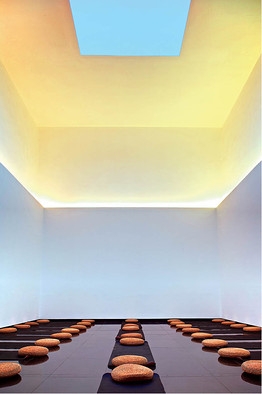(单词翻译:单击)

YOU NEVER KNOW what you'll find when you go bicycling in Beijing. Eight years ago, the Belgian entrepreneur Juan van Wassenhove set off from his home in the Chinese capital to pedal around the vanishing hutongs, the labyrinthine alleyways that were once the heart of the ancient city, when he glimpsed what appeared to be the tip of a stupa rising above slate-gray roofs. After shouldering open an iron gate, he was amazed to discover a derelict wooden temple with a beautiful double-level main hall crafted by artisans in the Qing Dynasty--a rare architectural treasure. 'That day I found my mission,' he recalls.
在中国首都骑车,你永远不知道会遇到什么。八年前,比利时创业家温守诺(Juan van Wassenhove)从北京的家中出发,踩着自行车逛那些像迷宫一样、曾经是这座古都的心脏、而今正在日渐消失的胡同。突然之间,他瞥见一个疑似佛塔尖顶的东西从青灰色的屋顶上冒出来。在用肩膀顶开一道铁门之后,他惊奇地发现了一座废弃的木头建成的寺庙。庙里有一个清代工匠建成的双层大殿,美轮美奂,是一件稀有的建筑珍宝。温守诺回忆说:“就在那一天,我找到了自己的使命。”
The antique structure--known to the faithful as Zhizhusi, the Temple of Wisdom--was one of three Tibetan Buddhist temples built in the mid-18th century near the Imperial Palace. Battered and charred by fire, the edifice was hardly promising for development. But years of restoration has transformed it into an art hotel with eight luxury rooms, a gallery, a restaurant, a courtyard adorned with sculptures and--in a surprisingly effective stroke--the only James Turrell Skyspace in China. Stripped of its bleak Communist facade, the near-ruined temple today has a new life, subtly blending Eastern spirituality with contemporary Western style.
这座古建筑被信众称为“智珠寺”,是18世纪中叶在皇宫附近修建的三座藏传佛教寺庙之一。由于被火烧过,以前这座寺庙没有了什么新生的希望。但经过多年的修复之后,它已经化身为一家艺术酒店,包含八个豪华房间,一家画廊,一家餐厅,一个装饰着雕塑作品的庭院,另外还有一个神来之笔,那便是詹姆斯・特瑞尔(James Turrell)在中国的唯一一件“Skyspace”作品。在去掉了共产主义时代风格的单调正面之后,这座几近毁灭的寺庙如今获得了新生,将东方的灵性同西方的当代风格微妙地结合在了一起。
The dramatic saga of China is written in its walls. In the mid-1700s, at the height of the wealthy Qing Dynasty, a pious emperor decided to build a Tibetan temple on the site, and Zhizhusi became home to a revered sage known as the Living Buddha. The sixth Living Buddha was still residing there two centuries later when the People's Liberation Army marched into Beijing in 1949, and symbols of the Imperial Age were repurposed for the Communist Revolution. Zhizhusi became a factory, first for mosaics, then bicycles, medical supplies and, in the 1970s, China's first black-and-white televisions. Neglected and abused, the building slowly decayed. 'Left to its own devices, the temple would not have lasted even three or four more years,' van Wassenhove says of his first visit in 2005.
中国风云多变的历史写在了寺庙的 上。18世纪中叶,正值清王朝的鼎盛时期,一位虔诚的皇帝决定在这个地方建一座藏式寺庙,于是便有了智珠寺,它是一位受人尊敬的 贤“活佛”的驻锡之地。两个世纪之后的1949年,当中国人民解放军进入北京的时候,六世活佛仍然在寺里居住。帝国时代的各种象征符号都纷纷为改为共产主义革命服务。智珠寺变成了一座工厂,先是生产金漆镶嵌产品,然后是自行车、医疗器械,70年代又生产了中国的第一批黑白电视机。因为无人看顾加上长期的无序使用,寺庙的建筑慢慢地衰败了下去。温守诺说,2005年他第一次到这里的时候,“若是任其自生自灭,这座寺庙三四年都撑不下去了。”
He contacted two business partners-- Lin Fan and Li Chow, both veterans of the local film industry--and in late 2007 the trio funded the removal of debris so investors could see the temple's potential. When a shabby modern ceiling within the main hall was removed, it revealed wooden panels covered with Sanskrit paintings. By 2008, when the plan for a boutique hotel was revealed, investors, mostly wealthy Chinese, were enthralled. 'It was the right time to do this project,' says van Wassenhove. 'After years of indifference, Chinese people of means are now interested in restoring architecture from the Imperial Age. Ten years ago, we wouldn't have had the skilled workers available in China.'
他联系了两位商业伙伴――中国电影行业资深人士林凡和周理贤。2007年年底,三人出资清理了废墟,让投资者能够看到这座古寺的潜力。当大殿内破败的现代的天花板被揭掉的时候,一些绘有梵文绘画的木板露了出来。到2008年,修建精品酒店的方案公布,以中国富人为主的投资人产生了深厚的兴趣。温守诺说:“做这个项目的时机选对了。经过多年的冷漠忽视之后,中国富人现在对修复帝国时代建筑很有兴趣。10年前我们在中国连相关的熟练工人都请不到。”
The public got its first glimpse in 2011, when a wing opened containing the Temple Restaurant Beijing, a palace of French gastronomy run by Ignace Lecleir, the Belgian-born former general manager of Daniel in Manhattan who moved to Beijing to open Maison Boulud in 2007. When he first saw the site, Lecleir was charmed by the space, but felt its condition was too poor for a serious business--until he saw the renovation. Today his restaurant attracts a mix of affluent expats, curious travelers and wealthy Chinese residents. 'I was worried that local Chinese people would avoid this neighborhood,' Lecleir says. 'Now they are about two thirds of our business.'
2011年,包含豪华法餐厅“Temple Restaurant Beijing”的一侧对外开放,公众首次得以窥见寺庙的真容。这家餐厅的经营者是出生于比利时、曾任曼哈顿Daniel餐厅总经理、在2007年搬到北京开办了“布鲁宫”(Maison Boulud)的伊尼亚斯・勒克莱尔(Ignace Lecleir)。第一次见到这个地方时,勒克莱尔被它的空间吸引,但感觉条件太差,不适合正儿八经的经营――等看到修复之后的样子感觉就不一样了。今天光顾他餐厅的既有富足的外籍人士、好奇的游客,也有有钱的中国人。勒克莱尔说,“我原本担心本地的中国人不会光顾这个区域,现在他们大约占到我们业务量的三分之二”。
The hotel is also a showcase for contemporary art, both Chinese and international, sourced by van Wassenhove through friends. 'I particularly wanted to find artists who work with light,' he says. 'It suits a temple.' The German light designers Ingo Maurer and Atelier Areti provided state-of-the-art illumination. But the coup was securing the James Turrell work Gathered Sky, which lured the notoriously reclusive artist himself to Beijing to fine-tune the design. 'James was very touched by the temple space,' says van Wassenhove. 'This is not a museum; it's a living place in an intensely urban setting. Being in the heart of a city with millions of people, it's the most accessible Turrell work in the world.'
酒店也是展示当代中外艺术作品的橱窗。作品是温守诺通过友人采购的。他说:“我当时特别需要找到处理光线的艺术家,因为光线艺术跟寺庙很搭。”德国灯光设计师英戈・毛雷尔(Ingo Maurer)和阿特利尔・阿雷蒂(Atelier Areti)设计了尖端的照明系统。但最妙的是詹姆斯・特瑞尔的作品“Gathered Sky”,这位以绝世独立而闻名的艺术家亲自到北京来对这个设计做了一番微调。温守诺说:“詹姆斯对智珠寺的空间感触很深。这个地方不是美术馆,而是闹市中的一个居所。它和数百万人一起处在城市的中心地带,是特瑞尔在世界上最平易近人的作品。”
The hotel is an oasis of relative calm within the traffic-clogged Chinese capital; here, one can still hear birds in the morning and spot the occasional butterfly. Several of the guest rooms are in the old TV factory, but more atmospheric is to sleep within the centuries-old chambers that were combined to make guest rooms; their floors heated in winter and lattice windows protected by double-glazed glass. And now, every Sunday at dusk, guests and the paying public can partake of the serene Turrell Skyspace. As classical music softly plays and LED lights complement the shifting colors of the waning day, I lie on the floor and watch swooping bats and then--miraculously for Beijing--two stars appear in the sky. After, I return to the hotel courtyard, past statues of tiny monks carrying small light bulbs like sabers, into the restaurant bar beneath Ming Dynasty eaves. 'I think we've extended the life of this temple for 300 years,' van Wassenhove tells me. 'I feel we've done our duty. Hopefully others will now follow suit.'
在交通拥堵的中国首都,这个酒店是一片相对宁静的绿洲。在这里,早上仍可听见鸟鸣,偶尔还会看到蝴蝶。原来的电视机厂里有好几间客房,但睡在利用有着几百年历史的僧人卧房组合而成的那些客房里才更有感觉。这些房间冬天有地暖,格子窗被双层玻璃保护着。现在,每个周日当夜幕降临的时候,客人和付费公众可以体验特瑞尔安详宁静的“Skyspace”作品。古典乐曲舒缓地奏起,LED灯光与不断变幻的暮色交相辉映。我躺在地板上,看着蝙蝠猛冲出来,然后又看到天上出现了两颗星星――在北京来说可谓奇迹。然后我回到酒店庭院,路过一个个像举着刀剑一样举着小灯管的微型僧人雕塑,进入位于明代屋檐之下的餐吧。温守诺对我说:“我想我们把这座寺庙的寿命延长了300年。我觉得我们已经完成了使命。希望其他人现在会跟着做。”


